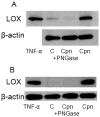Chlamydia pneumoniae induces expression of pro-atherogenic factors through activation of the lectin-like oxidized LDL receptor-1
- PMID: 23821487
- PMCID: PMC3871974
- DOI: 10.1111/2049-632X.12058
Chlamydia pneumoniae induces expression of pro-atherogenic factors through activation of the lectin-like oxidized LDL receptor-1
Abstract
Several lines of evidence have associated Chlamydia pneumoniae with cardiovascular disease including acceleration of atherosclerotic lesion progression in hyperlipidemic animal models by infection. Many of the pro-atherogenic effects of oxidized low-density lipoprotein (ox-LDL) occur through the activation of the lectin-like ox-LDL receptor-1 (LOX-1). Chlamydia pneumoniae upregulates the expression of the LOX-1 mRNA, promotes the uptake of ox-LDL, and utilizes the LOX-1 receptor for infectivity. The overall goal of this study was to determine whether C. pneumoniae organisms upregulated LOX-1 protein expression in vascular cells and whether upregulation of pro-atherogenic factors by C. pneumoniae occurred through LOX-1. Chlamydia pneumoniae induced LOX-1 protein expression in both endothelial cells and RAW macrophages. Upregulation was prevented by preincubation of cells with LOX-1 antibody prior to infection. Similarly, C. pneumoniae upregulated protein expression of adhesion molecules, MMP-1, and MMP-3, which was mitigated by anti-LOX-1 antibody. Prior treatment of organisms with PNGase, which removes the chlamydial glycan that is N-linked to the major outer membrane, abolished C. pneumoniae upregulation of LOX-1. These studies suggest that activation of LOX-1 expression occurs through binding of the chlamydial glycan and provides one mechanism by which C. pneumoniae infection could play a role in the pathogenesis of atherosclerosis.
Keywords: Chlamydia; LOX-1 receptor; adhesion molecules; atherosclerosis; glycan.
© 2013 Federation of European Microbiological Societies.
Conflict of interest statement
The authors have no conflicts of interest to declare.
Figures




Similar articles
-
Chlamydia pneumoniae binds to the lectin-like oxidized LDL receptor for infection of endothelial cells.Microbes Infect. 2012 Jan;14(1):43-9. doi: 10.1016/j.micinf.2011.08.003. Epub 2011 Aug 30. Microbes Infect. 2012. PMID: 21911078 Free PMC article.
-
Induced expression of lectin-like oxidized ldl receptor-1 in vascular smooth muscle cells following Chlamydia pneumoniae infection and its down-regulation by fluvastatin.Acta Microbiol Immunol Hung. 2010 Jun;57(2):147-55. doi: 10.1556/AMicr.57.2010.2.7. Acta Microbiol Immunol Hung. 2010. PMID: 20587387
-
Chlamydia pneumoniae infection enhances lectin-like oxidized low-density lipoprotein receptor (LOX-1) expression on human endothelial cells.FEMS Microbiol Lett. 2006 Jul;260(1):17-22. doi: 10.1111/j.1574-6968.2006.00286.x. FEMS Microbiol Lett. 2006. PMID: 16790013
-
LOX-1 receptor: A potential link in atherosclerosis and cancer.Life Sci. 2018 Apr 1;198:79-86. doi: 10.1016/j.lfs.2018.02.024. Epub 2018 Feb 17. Life Sci. 2018. PMID: 29462603 Review.
-
LOX-1, the receptor for oxidized low-density lipoprotein identified from endothelial cells: implications in endothelial dysfunction and atherosclerosis.Pharmacol Ther. 2002 Jul;95(1):89-100. doi: 10.1016/s0163-7258(02)00236-x. Pharmacol Ther. 2002. PMID: 12163130 Review.
Cited by
-
Manipulation of Host Cholesterol by Obligate Intracellular Bacteria.Front Cell Infect Microbiol. 2017 May 5;7:165. doi: 10.3389/fcimb.2017.00165. eCollection 2017. Front Cell Infect Microbiol. 2017. PMID: 28529926 Free PMC article. Review.
-
Chlamydia pneumoniae-Mediated Inflammation in Atherosclerosis: A Meta-Analysis.Mediators Inflamm. 2015;2015:378658. doi: 10.1155/2015/378658. Epub 2015 Aug 9. Mediators Inflamm. 2015. PMID: 26346892 Free PMC article. Review.
-
Current Status of Primary, Secondary, and Tertiary Prevention of Coronary Artery Disease.Int J Angiol. 2021 Aug 25;30(3):177-186. doi: 10.1055/s-0041-1731273. eCollection 2021 Sep. Int J Angiol. 2021. PMID: 34776817 Free PMC article. Review.
-
Biophysical regulation of Chlamydia pneumoniae-infected monocyte recruitment to atherosclerotic foci.Sci Rep. 2016 Jan 20;6:19058. doi: 10.1038/srep19058. Sci Rep. 2016. PMID: 26785849 Free PMC article.
-
Infection and Atherosclerosis Development.Arch Med Res. 2015 Jul;46(5):339-50. doi: 10.1016/j.arcmed.2015.05.006. Epub 2015 May 21. Arch Med Res. 2015. PMID: 26004263 Free PMC article. Review.
References
-
- Blessing E, Campbell LA, Rosenfeld ME, Chough N, Kuo CC. Chlamydia pneumoniae infection accelerates hyperlipidemia induced atherosclerotic lesion development in C57BL/6J mice. Atherosclerosis. 2001;158:13–17. - PubMed
-
- Campbell LA, Kuo CC. Chlamydia pneumoniae--an infectious risk factor for atherosclerosis? Nat Rev Microbiol. 2004;2:23–32. - PubMed
Publication types
MeSH terms
Substances
Grants and funding
LinkOut - more resources
Full Text Sources
Other Literature Sources
Miscellaneous

